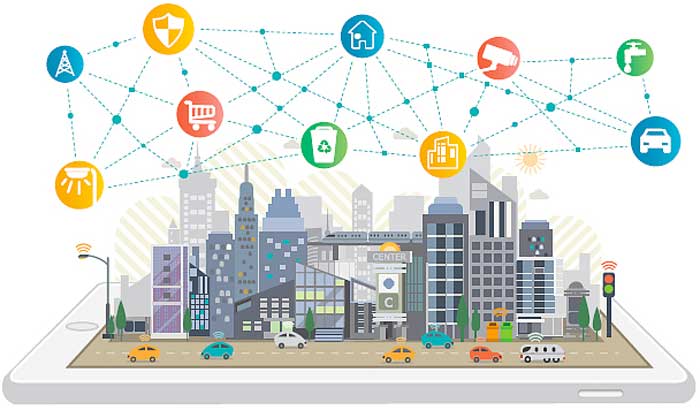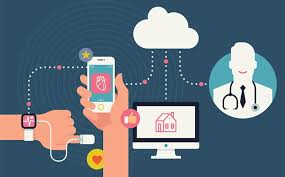

The term Internet of Things (IoT) describes a number of technologies and research disciplines that will enable the Internet to reach out to the real world of physical objects. According to the IoT paradigm, physical objects will be equipped with some communication capabilities, which will be exploited to coordinate their action and the way these objects influence the surrounding physical space. For example, books in a library could be equipped with RFID tags: in this way, each book could be precisely located by a system deployed in the library and, by communicating this information through the Internet, it would be possible to know the physical location of the book (or objects in general) from anywhere, by simply accessing these data.
A meaningful application is that of smart cities, where a system of smart lightening could automatically turn on and off street lights, according to the actual lightening conditions or could be easily configured through specific applications; smart parking system could suggest drivers where to find a place for their car, or sensors in the streets could inform about traffic congestions. In homes and buildings, networks of sensors will be able to acquire room temperature and humidity and use this information to control heating and ventilation. Wearable devices (smartwatches, wristbands) would permit the collection of biometrics data (e.g., heart rate, oxygen level, respiration, blood pressure, etc.) that can be used to help address the individual health and fitness needs of the users. Agriculture and breeding farms could also benefit from systems of sense-elaborate-control, for more efficient usage of hydric resources (e.g., soil moisture), control of production quality, and localization of animals and monitoring of their vital parameters.
Last but not the least, IoT can be applied in plants to realize some of the requirements at the basis of the Industry 4.0: also in this case, only through a system that connects all the machines and production means together it will be possible to accurately monitor the production quality, regulate production processes (such as heating/cooling procedures, packaging), check the use of the machines, track storage and, through proper control, avoid the waste of energy and raw materials and improve safety conditions.
Our focus
Many technologies are envisaged to face the diverse requirements of IoT, which can be specified for each particular application. Systems for sensing applications, for example, will need to host thousands of devices. Also, these nodes will be likely spread in a large area (e.g., a city, or a big farm), and their communication range should be large, in order to minimize the number of infrastructure needs. To lower maintenance costs, IoT devices should also have a long lifetime. All this translates into the network requirements of scalability, long communication range, energy efficiency, low device cost.
The so-called Low-Power Wide-Area Networks (LPWANs), are family of technologies that share the features of a long communication range and low energy consumption, features that make them the most suitable candidates for the IoT scenarios described above.
In our research group we are studying LPWANs technologies, analyzing how they perform in terms of scalability, energy efficiency, and communication reliability, facing different use cases. In particular, we are LoRaWAN, a world-wide spread LPWAN technology using unlicensed frequency bands, and NB-IoT, a cellular technology enabling multiple IoT services offered by big network operators.
For the analysis of LoRaWAN, we also developed the lorawan module for the network simulator ns-3, which made it possible to gain insights into the network protocol, point out some blemishes, and propose possible improvements. The software is publicly available and is helping the scientific community in LoRaWAN evaluations.
References and publications
- ns-3 lorawan module
- D. Magrin, M. Capuzzo and A. Zanella, “A Thorough Study of LoRaWAN Performance Under Different Parameter Settings,” in IEEE Internet of Things Journal, 2020. [Link]
- D. Magrin, M. Capuzzo, A. Zanella, and M. Zorzi. “A Complete LoRaWAN Model for Single-Gateway Scenarios”. arXiv preprint arXiv:1912.01285, 2019
- M. Capuzzo, D. Magrin and A. Zanella, “Confirmed traffic in LoRaWAN: Pitfalls and countermeasures,” 2018 17th Annual Mediterranean Ad Hoc Networking Workshop (Med-Hoc-Net), Capri, 2018. [Link]
- M. Capuzzo, D. Magrin, and A. Zanella. “Mathematical modeling of lora wan performance with bi-directional traffic.” 2018 IEEE Global Communications Conference (GLOBECOM). IEEE, 2018. [Link]
- D. Magrin, M. Centenaro and L. Vangelista, “Performance evaluation of LoRa networks in a smart city scenario,” 2017 IEEE International Conference On Communications (ICC), Paris, 2017. [Link]
- F. Michelinakis, A. S. Al-selwi, M. Capuzzo, A. Zanella, K. Mahmood, and A. Elmukashfi. “Dissecting Energy Consumption of NB-IoT Devices Empirically”. arXiv preprint arXiv:2004.07127, 2020
- F. Mason, F. Chiariotti, M. Capuzzo,D. Magrin, A. Zanella, and M. Zorzi, M. “Combining LoRaWAN and a New 3D Motion Model for Remote UAV Tracking”. arXiv preprint arXiv:2002.04849, 2020.
Other activities

We are working on real-time processing of human data from wearable and portable IoT devices for e-health and wellbeing applications. We are designing algorithms and developing lightweight and integrated software for on-device and real-time processing of human data, so that they can be effectively processed, stored in the limited memory of wearable IoT devices and conveniently transmitted over their wireless interface.
References and publications
- G. Cisotto, M. Capuzzo, A. V. Guglielmi, and A. Zanella, “Feature selection for gesture recognition in Internet-of-Things for healthcare”, International Conference on Communication (ICC) 2020, Virtual, arxiv preprint
- G. Cisotto, A. V. Guglielmi, L. Badia and A. Zanella, “Joint Compression of EEG and EMG Signals for Wireless Biometrics,” 2018 IEEE Global Communications Conference (GLOBECOM), Abu Dhabi, United Arab Emirates, 2018, pp. 1-6. doi: 10.1109/GLOCOM.2018.8647543. [Link]
Previous works
- We investigated motion analysis, activity recognition, and behavioral profiling using smartphone and wristband motion data for user identification and pattern analysis for preventive healthcare applications.
- We have been actively involved in the design of energy-efficient, scalable, and fully autonomous IoT systems. This entails the design of joint in-node and in-networks compression algorithms, minimizing the amount of data traffic generated within the network.
- We investigated energy scavenging techniques within WSNs (e.g., solar-powered devices or wireless transfer), through the joint design of communication and scheduling/control in the presence of harvested ambient energy or wireless energy transfer.
Related projects
- INTEL ISRA EC-CENTRIC (2015-2018)
- GRO SAMSUNG AWARD (biomedical data processing for IoT devices, 2014-2015)
- FP7 EU SWAP (energy harvesting sensor networks, 2010-2014)
- FP7 EU IoT-A (Internet of Things architectures, 2010-2013)
- CARIPARO WISE-WAI (City-wide intelligence through Wireless Sensor Networking, 2008-2010)
Collaborations
- SAMSUNG
- NEC Europe Ltd
- University of Twente
- CTTC: Centre Tecnològic de Telecomunicacions de Catalunya
- University College of Dublin
- Docomo Eurolabs
- Intel
Contacts

Michele Rossi
http://www.dei.unipd.it/~rossi/
Andrea Zanella
http://www.dei.unipd.it/~zanella/
Michele Zorzi
http://www.dei.unipd.it/~zorzi/
